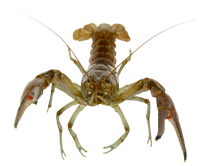Behavioral Neuroscience, lecture on Lateral Giant Neuron control of Crayfish Escape
Escape - Crayfish
XI. Motor Neurons and the Crayfish tail-flip Escape
A. Two sets of motor neurons
1. Motor Giants (MoG 1-6)
a. bilateral neurons for each abdominal segment
b. required for rapid sterotypical single flip escape
i. Two types of Escape
1) Full-flip Retreat
2) Upward Thrust
2. Fast Flexor motor neurons (FF 1-6)
a. multiple segmental neurons
b. recruited for stereotypical and flexible tail-flips
i. required for adjustments to direction, speed or duration
1) required for swimming
B. MoG
1. Stimulated directly by MGs or LGs
2. MGs stimulates all MoGs
a. LGs stimulates only rostral MoGs (MoG 1-3)
3. MGs and LGs commensurately stimulate FFs
a. MGs stimulates all FFs (FF 1-6)
b. LGs stimulate only* rostral FFs (FF 1-3)
4. MoG output produces only one tail flip
C. FF motor neurons
1. Stimulated by a parallel network of premotor interneurons
a. premotor interneurons stimulated by Non-Giant (NG) neurons
2. Also stimulated by MG or LG à SG connections
a. SGs à premotor
i. premotor à FF
b. SGs à FF
c. LG-SIs inhibit FF 4-6
3. Fast flexors alone produce slower tail flips
a. FF enhance the action of MoG fast tail flips
D. ACh secreted from MoG and FF motor neurons projecting from each ganglion
to the longitudinal, oblique and circumferential muscles
E. ACh binds to Nicotinic receptors at a neuromuscular synapse
1. stumulates action potential (= end-plate potential or EPP) by opening
transmitter-gated Na+ and K+ channel (even Ca++ passes; a large
diameter channel)
a. along sarcolemma and into transverse tubules
i. opens voltage gated Ca++ channels in
sarcoplasmic reticulum
(1) binds to troponin
(a) conformational change in
tropomyosin uncovers binding
site for myosin on actin
(i) myosin binds
to actin
(ii) conformational change
(muscle contracts)
(iii) ATP allows unbinding
of actin
ii. Ca++ATPase returns Ca++ to cisternae
of sarcoplasmic reticulum
F. Useful Movement: contraction of longitudinal abdominal hemi-segmental muscles
1. Contractile force summates for each muscle cell
a. MoG + FF produce maximal summation and contraction
i. in just one flip
b. for FFs summation requires repeated EPP's (before fiber relaxes)
i. \ requires Ca++ restoration to cisternae
ii. \ contractile force depends on initial length
2. the Nervous System Grades the force of muscle contraction
a. single motor axon innervates a single muscle fiber (cell)
b. one motor neuron (many axons) innervates a number
of muscle fibers = Motor Unit
i. smallest functional unit
1) magnitude of contractile function depends
on innervation ratio (fibers/neuron)
c. graded force is dependent upon motor unit recruitment
i. degree of shortening
ii. local direct motor innervation
1) segmental gradation in FF tail flips
d. motor units are recruited in a fixed order
i. weakest to strongest in FF
1) allows fine motor actions
2) integrated changes during tail flip swimming
a) changes in speed or direction
3) all abdominal motor units are recruited under MG drive
4) all rostral abdominal motor units are recruited under LG drive
e. ñ firing rate ñ force
i. more effective summation (see C 1)
1) for FF modulated tail flip swimming
ii. not pertinent for MG or LG stimulation
G. Sudden rostral sensory stimulation produces MG mediated full tail flip
1. sudden caudal stimulation produces LG mediated upward thrust tail flip
2. MG full tail flip or LG upward thrust are often followed by NG swimming
a. making the escape response more variable and \ more adaptive
